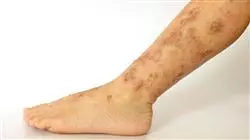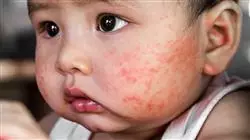University certificate
The world's largest faculty of medicine”
Introduction to the Program
Improve your knowledge in Pediatric Dermatology through this program, where you will find the best teaching material with real clinical cases. Learn here about the latest advances in the specialty to be able to provide quality medical care"

At the diagnostic level, the advances that are being made in the knowledge of the etiology of each of the diseases, emerging pathologies, new imaging and laboratory techniques, and diagnostic algorithms that are in continuous renewal, requires us to keep our knowledge of Pediatric Dermatology and other related specialties (Pediatrics, Genetics, Radiology, etc.) continuously updated.
At the therapeutic level, the appearance of new drugs and techniques for already known pathologies and the need for new strategies for the integral approach of the patient, makes it more than necessary to know all this arsenal of resources that we can, if necessary, use to attend our patients with the maximum guarantee.
The program is designed to provide an online education equivalent to 1,500 hours of study and all the theoretical and practical knowledge is presented through high quality multimedia content, analysis of clinical cases prepared by experts, master classes and video techniques that allow the exchange of knowledge and experience, maintaining and updating the educational level of its members, creating protocols for action and disseminating the most important developments in the specialty. With online education, students can organize their time and pace of learning, adapting it to their schedules, in addition to being able to access the contents from any computer or mobile device.
Up to date knowledge through the Professional master’s degree program in Pediatric Dermatology"
This Professional master’s degree in Pediatric Dermatology contains the most complete and up to date scientific program on the market. The most important features include:
- More than 75 clinical cases presented by experts in pediatric dermatology
- The graphic, schematic, and practical contents with which they are created provide scientific and practical information on the disciplines that are essential for professional practice
- Diagnostic-therapeutic developments on assessment, diagnosis and treatment in pediatric dermatology
- It contains practical exercises where the self-evaluation process can be carried out to improve learning
- Iconography of clinical and diagnostic imaging tests
- An algorithm-based interactive learning system for decision-making in the clinical situations presented throughout the course
- With special emphasis on evidence-based medicine and research methodologies in pediatric dermatology
- All of this will be complemented by theoretical lessons, questions to the expert, debate forums on controversial topics, and individual reflection assignments
- Content that is accessible from any fixed or portable device with an Internet connection
This Professional master’s degree is the best investment you can make for two reasons: you will obtain a qualification accredited by TECH Global University, and you will acquire the best and most up-to-date education in Pediatric DermatologyPediatric Dermatology
The teaching staff includes professionals from the field of Pediatric Dermatology, who bring their experience to this training program, as well as renowned specialists from leading scientific societies.
The multimedia content developed with the latest educational technology will provide students with situated and contextual learning, i.e., a simulated environment that will provide immersive learning programmed to train in real situations.
This program is designed around Problem-Based Learning, whereby the physician must try to solve the different professional practice situations that arise during the course For this purpose, the physician will be assisted by an innovative interactive video system created by renowned and experienced experts in the field of Pediatric Dermatology with extensive teaching experience.
It includes clinical cases to bring the development of the Professional master’s degree as close as possible to the reality of medical practice"

Take the opportunity to learn about the latest advances in this field and apply it to your daily practice"
Why study at TECH?
TECH is the world’s largest online university. With an impressive catalog of more than 14,000 university programs available in 11 languages, it is positioned as a leader in employability, with a 99% job placement rate. In addition, it relies on an enormous faculty of more than 6,000 professors of the highest international renown.

Study at the world's largest online university and guarantee your professional success. The future starts at TECH”
The world’s best online university according to FORBES
The prestigious Forbes magazine, specialized in business and finance, has highlighted TECH as “the world's best online university” This is what they have recently stated in an article in their digital edition in which they echo the success story of this institution, “thanks to the academic offer it provides, the selection of its teaching staff, and an innovative learning method aimed at educating the professionals of the future”
A revolutionary study method, a cutting-edge faculty and a practical focus: the key to TECH's success.
The most complete study plans on the university scene
TECH offers the most complete study plans on the university scene, with syllabuses that cover fundamental concepts and, at the same time, the main scientific advances in their specific scientific areas. In addition, these programs are continuously being updated to guarantee students the academic vanguard and the most in-demand professional skills. In this way, the university's qualifications provide its graduates with a significant advantage to propel their careers to success.
TECH offers the most comprehensive and intensive study plans on the current university scene.
A world-class teaching staff
TECH's teaching staff is made up of more than 6,000 professors with the highest international recognition. Professors, researchers and top executives of multinational companies, including Isaiah Covington, performance coach of the Boston Celtics; Magda Romanska, principal investigator at Harvard MetaLAB; Ignacio Wistumba, chairman of the department of translational molecular pathology at MD Anderson Cancer Center; and D.W. Pine, creative director of TIME magazine, among others.
Internationally renowned experts, specialized in different branches of Health, Technology, Communication and Business, form part of the TECH faculty.
A unique learning method
TECH is the first university to use Relearning in all its programs. It is the best online learning methodology, accredited with international teaching quality certifications, provided by prestigious educational agencies. In addition, this disruptive educational model is complemented with the “Case Method”, thereby setting up a unique online teaching strategy. Innovative teaching resources are also implemented, including detailed videos, infographics and interactive summaries.
TECH combines Relearning and the Case Method in all its university programs to guarantee excellent theoretical and practical learning, studying whenever and wherever you want.
The world's largest online university
TECH is the world’s largest online university. We are the largest educational institution, with the best and widest online educational catalog, one hundred percent online and covering the vast majority of areas of knowledge. We offer a large selection of our own degrees and accredited online undergraduate and postgraduate degrees. In total, more than 14,000 university degrees, in eleven different languages, make us the largest educational largest in the world.
TECH has the world's most extensive catalog of academic and official programs, available in more than 11 languages.
Google Premier Partner
The American technology giant has awarded TECH the Google Google Premier Partner badge. This award, which is only available to 3% of the world's companies, highlights the efficient, flexible and tailored experience that this university provides to students. The recognition as a Google Premier Partner not only accredits the maximum rigor, performance and investment in TECH's digital infrastructures, but also places this university as one of the world's leading technology companies.
Google has positioned TECH in the top 3% of the world's most important technology companies by awarding it its Google Premier Partner badge.
The official online university of the NBA
TECH is the official online university of the NBA. Thanks to our agreement with the biggest league in basketball, we offer our students exclusive university programs, as well as a wide variety of educational resources focused on the business of the league and other areas of the sports industry. Each program is made up of a uniquely designed syllabus and features exceptional guest hosts: professionals with a distinguished sports background who will offer their expertise on the most relevant topics.
TECH has been selected by the NBA, the world's top basketball league, as its official online university.
The top-rated university by its students
Students have positioned TECH as the world's top-rated university on the main review websites, with a highest rating of 4.9 out of 5, obtained from more than 1,000 reviews. These results consolidate TECH as the benchmark university institution at an international level, reflecting the excellence and positive impact of its educational model.” reflecting the excellence and positive impact of its educational model.”
TECH is the world’s top-rated university by its students.
Leaders in employability
TECH has managed to become the leading university in employability. 99% of its students obtain jobs in the academic field they have studied, within one year of completing any of the university's programs. A similar number achieve immediate career enhancement. All this thanks to a study methodology that bases its effectiveness on the acquisition of practical skills, which are absolutely necessary for professional development.
99% of TECH graduates find a job within a year of completing their studies.
Professional Master's Degree in Pediatric Dermatology
Pediatric care is a fundamental part of early childhood health, so professionals in this sector must be continuously educated to carry out the best processes in their daily practice. At TECH Global University we are committed to train specialized individuals, which is why we designed the Professional Master's Degree in Pediatric Dermatology as an excellent opportunity for preparation in the medical field. Our program consists of 1,500 instructive hours, within which students will have access to an innovative curriculum that will facilitate the structuring of knowledge about the different skin pathologies in the child and adolescent population. As a result, each student will be able to make diagnoses, treatments and prevention plans that meet the patient's needs.
Study a Postgraduate Certificate in Pediatric Dermatology Online
This TECH program has a state-of-the-art teaching system. Throughout the curriculum, students will develop simulated practical cases, which will boost their skills in the resolution of complex cases; this will prepare them to face all possible situations present in routine practice. In addition, throughout the program they will have access to high quality contents that will allow them to acquire the necessary knowledge related to cutaneous pathology and blistering diseases. Thanks to our online modality, our students will have the possibility of coordinating their study schedules according to their daily needs or occupations.







